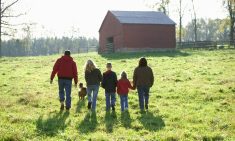You use the winter to get ready for spring. Now, use the summer to get ready for the winter business season.
With a sigh of relief mixed with equal parts of pride and exhaustion, you climb down from the tractor seat. The fertilizer is spread, the crop is growing and the weeds are under control. It’s time to recuperate at last and to enjoy some time with your family.
But hold on a moment. It isn’t only the crops that grow during the spring and summer. Great ideas, keen observations and the kinds of insights that can shape your farm’s future are ripe for the picking too.
Read Also

What to consider when setting up farm-related business ventures
Things to consider before launching a farm-adjacent side business.
And here’s the best part. Now, when you’re still in full gear in the summer, can be the perfect time to start planning and prioritizing so that you’ll get every last ounce of benefit out of the winter business season that’s just around the proverbial corner.
Still not sure? Then read on…
“In many ways it is like being an athlete, and summer is game day,” says Jerry Bouma of Toma + Bouma Management Consultants in Edmonton. When you’re in the thick of operations, Bouma means, you’ve got the year’s best opportunity to see what works and what doesn’t, which in turn is critical for planning.
Whether they know it or not, top farmers are constantly reviewing their farm’s vision. They’re assessing how well their current plan is working out. They’re evaluating and gathering data and identifying opportunities. And just when a lot is happening on the farm, they’re subconsciously thinking about it, rating it, and imagining new opportunities even more.
Several years ago Bouma was involved in a survey of leading farmers in Western Canada. The research concluded that each of these farmers had a vision for their business, each was confident, motivated, and showed strong leadership, and each excelled at managing risk, finances, marketing and people. They were proactive at forming alliances, improving production, seeking out innovation and managing environmental issues. They were on top of management and planning.
“Leading managers and farmers are planning all the time,” says Bouma.
At the core of planning is a three-step process, says Bouma. First you define a clear vision toward which you’re working or aspiring. Second, you gather information, data, and insights that you need to evaluate your current position, while at the same time identifying the key initiatives that are critical toward achieving your vision. Finally, you develop the actual plan itself.
Summer planning tends to be very informal, setting the stage for winter action. It involves picking a few key business priorities and mulling them over before you start digging into the nuts and bolts. It is also a time for observation, listening and noticing impacts.
This summer, spend a little time on the following six business initiatives. They can help fuel your winter business planning, smoothe your pathway to change, and expand your opportunities for growth.
Identify improvements
There’s no better time to get a grip on what is working well, what needs to be improved and what needs to be discontinued than when you’ve just lived through the repercussions. During a break in the action, jot down the ideas you’ve had. When you spend so many hours in a tractor or a pickup, you can think of lots of ideas that evaporate and disappear before the day is over.
Some of them may seem like small ideas. But because everything on the farm is so interconnected, sometimes it’s the small ideas that create a trail that leads to the great big ones.
So keep track in May and June. Then, start choosing some as your business priorities for next winter. For example, maybe after paying income tax in the spring, you want to focus on incorporating your business, and you can use the summer to figure out who you will turn to for more information and for professional advice. Or if you struggled hiring someone, you might want to work on recruitment.
Successful farmers take charge. They introduce new ways of doing things better and more efficiently. This includes adopting new technologies and genetics or even seeking out important new findings from business researchers and thinkers. Then, get a rope around your desire to make change. Lasso it when it’s bucking.
Be ready for unexpected opportunities
The reality is that some opportunities for investment aren’t budgeted for, and successful farmers are often the ones who can jump on these chances. Although summer isn’t the time for a full financial planning session, it might be ideal for reviewing your costs and how they compare to forecast.
“Make a budget at the beginning of the year and track it month by month with your bank statement,” says Art Lange, financial consultant at Sherwood Park, Alta.
Reviewing actual costs and plugging them into your budget will help keep you on top of the farm’s cash flow position and marketing requirements. Then decisions on purchases, marketing and production are made based on profitability projections, both short- and long-term.
Although not much land is traded with standing crops, being financially prepared allows for deals to be done whatever the time of the year. Access to credit can be pre-planned, says Lange, either by using vendor credit and grain advances or by keeping in touch with your loan manager.
Above all, don’t forget to take care of your emotional health. “Financial performance is important, but farmers need a family life too,” says Lange.
Be the first to enrol
Summer is an excellent time to determine exactly what you need to learn, and then to prioritize education needs for family and employees. Setting a midsummer deadline for people to select skills enhancement and educational opportunities will improve the chances of being accepted into certain programs and give people a dose of focus and motivation during harvest.
Some courses have summer deadlines and incentives for signing up early. Agri-Food Management Excellence (formerly the education part of the George Morris Centre) offers early-bird C-TEAM applicants a five per cent discount if they apply by July 15, although applications are accepted until three weeks before the course starts in December.
Professional development should be a part of a farm’s business plan, says Heather Broughton, who is a principal at AME Inc. and part-owner of SWG Farms in Alberta. “The agricultural industry is changing quickly and in order to stay competitive and ahead of the game, learning needs to be a continuous process.”
Broughton has personally seen how powerful it can be to purposely plan to take time to step out of the day-to-day operations of a farm and learn how to incorporate ideas and skills to strengthen the business. She has completed the C-TEAM program and the TEPAP program through Texas A+M.
At www.agritalent.ca is a list of potential courses that helps you select topics and locations. Also, if geography is an issue, several companies and agencies have built a fairly large collection of learning videos. FCC has some at www.fcc.ca/multimedia, the Agricultural Management Institute’s series is at www.takeanewapproach.ca and there are good webinars at Farm Management Canada at www.farmcentre.com.
Also keep in mind that learning opportunities have become more mobile. For example, several agricultural companies have been producing podcasts which are particularly popular in the busy spring and summer months. That includes the FCC Edge audio podcast, designed for farmers to listen to while on the go using their smartphones or mp3 players.
“Today’s best and brightest farmers are very intentional in their personal growth strategy,” says Mike Tisdall, who manages the FCC learning team. “Learning is an important component in your farm’s business growth strategy.”
FCC offers over 160 learning events all across Canada from November to March. This past year, 13,000 individuals attended these events, an increase in over 1,500 from last year.
Touch base with employees
Before you fire up the fishing boat, take a moment to open up communication with your employees. Although full performance reviews in the summer might not work so well, taking time to talk to your employees while they are actively engaged in their in-season work is a perfect opportunity to connect with them and keep them charged up by ensuring they know how important their work is.
Bouma’s best management practices survey indicated that only about half of top producers conducted formal performance appraisals. However, open communication with employees is really important and it can be quite informal.
Human resource experts say there’s only one answer to the question of when to communicate with employees, including family. It’s, “Often.” Listening to and speaking with employees about how they’re doing and how that relates to your farm’s visions can be motivating. Staying connected also allows managers and employees to address little problems as they occur. Remember, too, that telling employees the good job they’re doing this summer may make it easier for them to accept constructive criticism later.
A complete formal human resource management system takes time and effort; it’s not something you can throw together between loads of hay. If you don’t have one, summer is a good time to make it a priority for next winter’s to-do list. It’s also a great time to identify the challenges the farm faces and then determine if employee incentives or training will help.
For future reference, the Canadian Agricultural Human Resources Council has created online step-by-step instructions on how to create an HR plan for your farm, including how to set compensation and safety standards and, templates for things like job advertising and termination letters. Available as of April 1 for $99, you can now source it online.
Think transition
This summer might be the right time to start exploring whether you want to sell the farm to an external party or transfer the farm within the family, says Grant Robinson, accountant and coach for Successcare in Guelph, Ont. Start with that single choice, Robinson recommends, and keep an open mind.
Next you need to define what you and your spouse want in the future for your business, your family and your ownership. It’s a conversation you can have on your front porch on a quiet evening or while you’re on a summer drive together. What’s important to you and your spouse? How do you want to retire? Is keeping the land in the family important to both of you?
Robinson has created a pathway of choices for the Agriculture Management Institute at TakeANewApproach.ca. Window by window, you select one of two choices, leading to options, examples, and worksheets. It’s a slick, anonymous way to steer through a very complex, confusing and emotional decision.
Only once you get through these preliminary choices, work out the framework of a plan for making your choice happen.
Don’t expect everyone to jump on the idea or make quick decisions without much information. Robinson has met farmers who in the middle of a busy day wandered up to their sons and asked if they’re in or out. They didn’t give them any information about the business, yet they expected an immediate, confident answer.
For similar reasons, Robinson says it isn’t wise to call a family meeting when everyone’s busy or right before someone goes on holidays. “It’s like throwing a bomb in the room,” he says.
This summer might be a good time to select a date in the winter to meet with the stakeholders to share relevant facts and get input from the next generation. Just don’t keep it to yourself.
Set a meeting to formalize plans
“Perhaps the most important decisions to be made in the summer might be answering: When do we plan to sit down and do more formal planning?” says Bouma.
For best results, Bouma suggests setting a time and place with a minimum of distractions for sometime during the next winter. Some farmers prefer to conduct their planning on site with their management team, which can include employees, spouses, siblings or children. Others prefer to go to an offsite retreat location where they can fully engage in planning without the noise of everyday business.
When you set the date and place, also select who needs to be involved in the plan. There’s gathering input from people in advance and then there’s selecting who needs to be part of the plan. It’s important to consider who should have ownership in the plan.
“You can have the best plan in the world,” says Bouma, “but if it requires a team to execute and the team is not part of the planning process, you have a problem.”
— Maggie Van Camp is an associate editor with Country Guide at Blackstock, Ont. This article originally appeared in the April 2013 issue.














